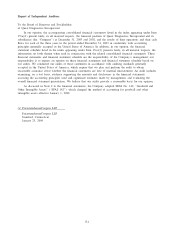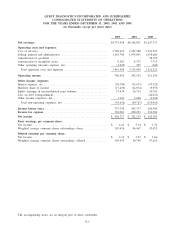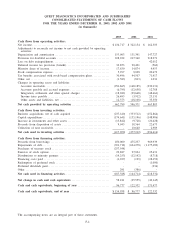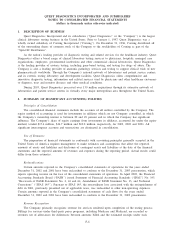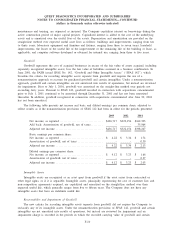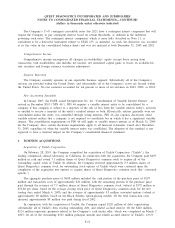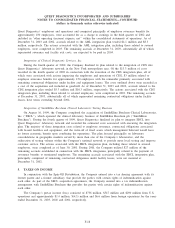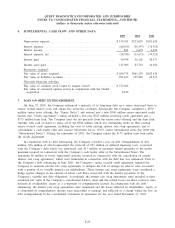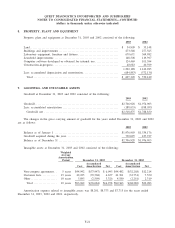Quest Diagnostics 2003 Annual Report Download - page 80
Download and view the complete annual report
Please find page 80 of the 2003 Quest Diagnostics annual report below. You can navigate through the pages in the report by either clicking on the pages listed below, or by using the keyword search tool below to find specific information within the annual report.QUEST DIAGNOSTICS INCORPORATED AND SUBSIDIARIES
NOTES TO CONSOLIDATED FINANCIAL STATEMENTS—CONTINUED
(dollars in thousands unless otherwise indicated)
intangibles is more than its estimated fair value. The provisions of SFAS 142 require that a transitional
impairment test be performed as of the beginning of the year the statement is adopted. The provisions of
SFAS 142 also require that a goodwill impairment test be performed annually or in the case of other events
that indicate a potential impairment. The Company’s transitional impairment test indicated that there was no
impairment of goodwill upon adoption of SFAS 142 effective January 1, 2002. The annual impairment test of
goodwill was performed at the end of the Company’s fiscal year on December 31st and indicated that there was
no impairment of goodwill as of December 31, 2003.
Effective January 1, 2002, the Company evaluates the recoverability and measures the potential impairment
of its goodwill under SFAS 142. The annual impairment test is a two-step process that begins with the
estimation of the fair value of the reporting unit. The first step screens for potential impairment and the second
step measures the amount of the impairment, if any. Management’s estimate of fair value considers publicly
available information regarding the market capitalization of the Company as well as (i) publicly available
information regarding comparable publicly-traded companies in the clinical laboratory testing industry, (ii) the
financial projections and future prospects of the Company’s business, including its growth opportunities and
likely operational improvements, and (iii) comparable sales prices, if available. As part of the first step to assess
potential impairment, management compares the estimate of fair value for the Company to the book value of
the Company’s consolidated net assets. If the book value of the consolidated net assets is greater than the
estimate of fair value, the Company would then proceed to the second step to measure the impairment, if any.
The second step compares the implied fair value of goodwill with its carrying value. The implied fair value is
determined by allocating the fair value of the reporting unit to all of the assets and liabilities of that unit as if
the reporting unit had been acquired in a business combination and the fair value of the reporting unit was the
purchase price paid to acquire the reporting unit. The excess of the fair value of the reporting unit over the
amounts assigned to its assets and liabilities is the implied fair value of goodwill. If the carrying amount of the
reporting unit’s goodwill is greater than its implied fair value, an impairment loss will be recognized in the
amount of the excess. Management believes its estimation methods are reasonable and reflective of common
valuation practices.
On a quarterly basis, management performs a review of the Company’s business to determine if events or
changes in circumstances have occurred which could have a material adverse effect on the fair value of the
Company and its goodwill. If such events or changes in circumstances were deemed to have occurred, the
Company would perform an impairment test of goodwill as of the end of the quarter, consistent with the annual
impairment test, and record any noted impairment loss.
Prior to 2002, the Company evaluated the recoverability and measured the possible impairment of goodwill
under APB Opinion No. 17, “Intangible Assets’’ based on a fair value methodology. The fair value method was
applied to each of the regional laboratories. Management’s estimate of fair value was primarily based on
multiples of forecasted revenue or multiples of forecasted earnings before interest, taxes, depreciation and
amortization. The multiples were primarily determined based upon publicly available information regarding
comparable publicly-traded companies in the industry, but also considered (i) the financial projections of each
regional laboratory, (ii) the future prospects of each regional laboratory, including its growth opportunities,
managed care concentration and likely operational improvements, and (iii) comparable sales prices, if available.
During 2001, no impairments of goodwill were recorded.
Recoverability and Impairment of Intangible Assets and Other Long-Lived Assets
Effective January 1, 2002, the Company evaluates the possible impairment of its long-lived assets, including
intangible assets which are amortized pursuant to the provisions of SFAS 142, under SFAS No. 144,
“Accounting for Impairment or Disposal of Long-Lived Assets’’ (“SFAS 144’’). The Company reviews the
recoverability of its long-lived assets when events or changes in circumstances occur that indicate that the
carrying value of the asset may not be recoverable. Evaluation of possible impairment is based on the
Company’s ability to recover the asset from the expected future pretax cash flows (undiscounted and without
interest charges) of the related operations. If the expected undiscounted pretax cash flows are less than the
carrying amount of such asset, an impairment loss is recognized for the difference between the estimated fair
value and carrying amount of the asset. The Company’s adoption of SFAS 144 did not result in any impairment
loss being recorded.
F-11


